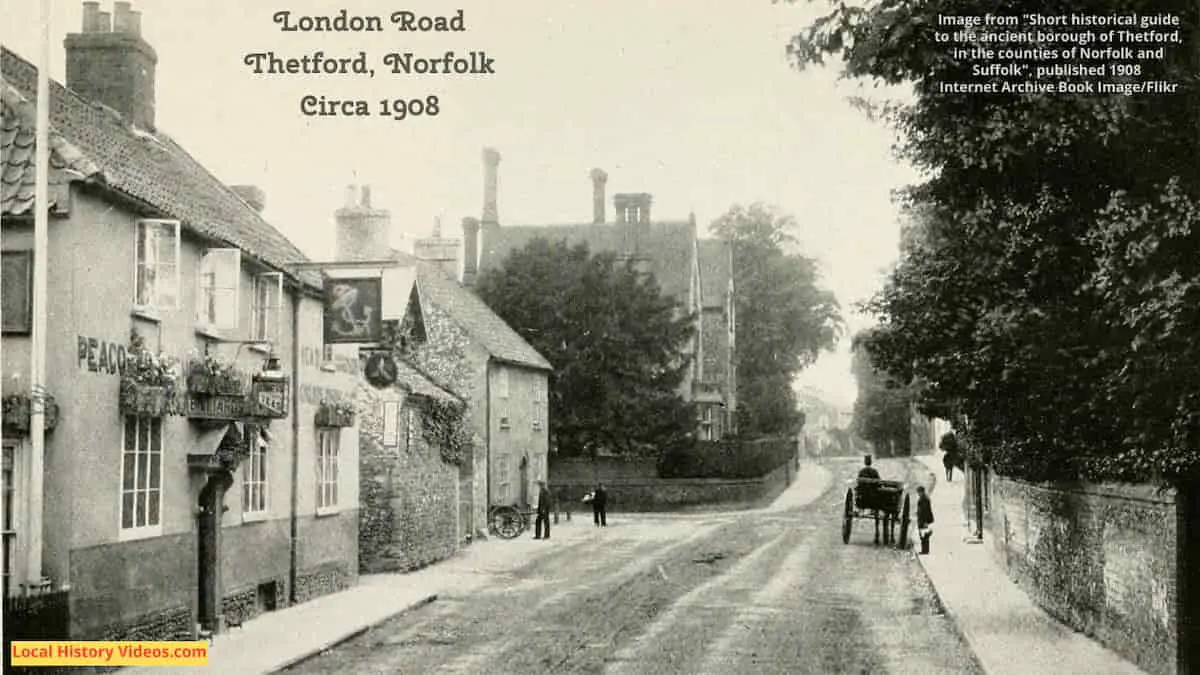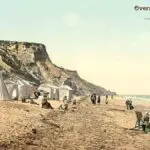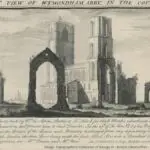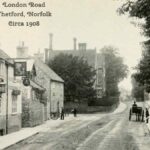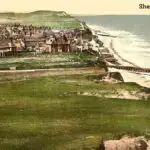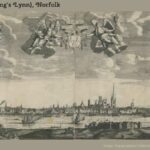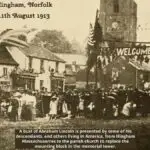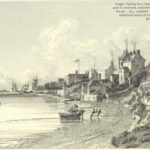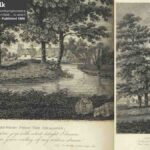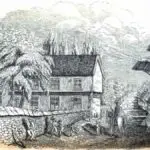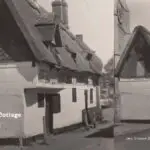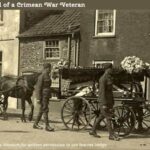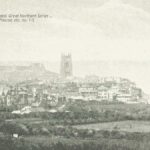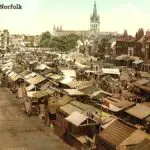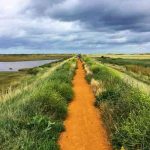Glimpse history through old images of Thetford, Norfolk, England.
Thetford Chase Forest (1948)
In 1948, forestry commission staff looked after almost 2 million acres of publicly owned woodlands.
One year, over 1800 acres of forest were destroyed by fires, usually caused by a dropped cigarette by people on a picnic. It had caused the loss of nearly 3 million trees, worth £45,000.
This newsreel shows the look out towers used to spot forest fires, and a fire response team in a practice run.
Forest Fire Control (1948) – British Pathé on YouTube
A Bit of Thetford History
Extract from “Post office directory of the Norfolk counties; viz.: – Cambridge, Norfolk, Suffolk [afterw.] Post office directory of Cambridge, Norfolk and Suffolk [afterw.] The Post office directory of Norfolk and Suffolk [afterw.] Kelly’s directory of Cambridgeshire, Norfolk and Suffolk”, by Kelly’s Directories, Ltd.
Published in 1875
Pages 465 – 466
THETFORD is an ancient borough, railway station, market town, municipal borough, and polling place for the South division of the county, chiefly in Norfolk, but a small part is in Suffolk; the counties are divided by the Little Ouse, over which is a cast – iron bridge, erected by the corporation in 18:20.
The rivers Thet and Little Ouse join a little above the bridge.
The town is the head of a union and county court district, in the rural deanery of Thetford, and archdeaconry and diocese of Norwich, 7 miles east – south – east from Brandon, 12 from Bury St. Edmund’s, 23 from Ely, 31 south – west from Norwich, 204 south – east from Wymondham, 28 south – south – east from Lynn, 78 north – east from London by road and 95 by rail: it is governed by a mayor, recorder, four aldermen, twelve councillors, and town clerk, and is lighted with gas.
The Little Ouse is navigable by barges from Lynn to Thetford, by which quantities of coal and timber are imported, and corn, malt, and wool exported.
The Great Eastern railway has a station on the northern side of the town, and a line of railway connects the town with Bury St. Edmund’s.
The borough formerly returned two members to Parliament; by the “Representation of the People Act, 1867, ” it was to have returned one, but the one member was lost on the passing of the “Representation of the People (Scotland) Act, 1868. ”
The town consists of three parishes: -St. Mary, St. Peter, and St. Cuthbert. St. Mary’s church, situated on the Suffolk side, is a large and very ancient structure, restored in 1866; it consists of a chancel, nave, and lofty square tower with 6 bells; the west gallery has been removed, the east and west windows have been filled with stained glass, the former is very beautiful, the subject being The Crucifixion; it was inserted by the family of the late rector, the Rev. William Collett, M.A.; two other stained windows are placed in the nave, and the family of the late L. S. Bidwell, esq., one of the oldest inhabitants of the town, have placed others in the chancel to his memory; the tomb of Sir Richard Ful merstone, knt., was some years since removed, and the parts containing the inscription were placed flat against the south wall of the nave.
The register dates from the year 1653. The living is a rectory, yearly value £ 83, in the gift of trustees, and held by the Rev. Alfred Fowler Smith, M.A., of Pembroke College, Cambridge, who is also preacher of the school and hospital.
St. Peter’s, White Hart street, is built of flint, whence it was formerly called the “Black Church;” it consists of a chancel, nave, and aisles; the tower was rebuilt in 1789, and contains a fine peal of 8 bells, which were re – hung in 1875 by the exertions of the rector, at the cost of £ 40, nothing having been done since 1791, when the bells were placed in the belfry by Lord Petre.
The register dates from the year 1642. The living is a rectory, yearly value £ 122, in the gift of W. P. Snell, esq., and held by the Rev. Reginald Hay – Hill, LL.D., of Trinity Hall, Cambridge.
St. Cuthbert’s church, situated near the Market place, was almost rebuilt in 1852; it is very handsome, consisting of chancel, nave, and aisles; the chancel is separated from the nave by a beautiful oak screen.
The register dates from the year 1672. The living is a vicarage, yearly value £40, in the gift of John Shackleton, esg., and held by the Rev. Thomas Burne Simpson, M.A., of Lincoln College, Oxford.
The Cemetery, on the London road, established 1854, occupies about 3 acres of land, and has two mortuary chapels.
The Grammar school, well endowed, was founded by Act of Parliament in 1610, according to the last will and testament of Sir Richard Fulmerston, knt.; there are good residences for the head and the second masters; the school – house, a detached building, is part of the old Trinity church; one of the original arches is still in a good state of preservation, at the upper end of the school – room, over the lead master’s desk. A draft scheme for the management of this ancient foundation has recently been issued, and is in process of settlement.
There is a fund for apprenticing out of Williamson’s charity.
The British school is in Nether row, and will hold 150 boys, the National school is in White Hart street, erected in 1825, and enlarged in 1857, and will hold 250 of both sexes.
There are chapels for Baptists, Independents, Primitive Methodists, and Wesleyans, and a Friends ‘ meeting – house, seldom used; also a Roman Catholic chapel on the London road.
The market is held on Saturday for fish, ment, and vegetables.
The fairs are held August 2nd and 16th.
The Guildhall, where the quarter sessions for the borough are held, is situated in the centre of the town, overlooking the Market place, which is encircled by an iron railing.
Petty sessions for the borough are held at the Guildhall Monday and Thursday.
The Gaol, enlarged in 1816, is a flint and stone building, but since the removal of the assizes to Norwich, in 1833, is now only a police station.
The Mechanics ‘ Institution has a library of 1,561 volumes.
The Union Workhouse is situated on the Bury road; it is a brick building, capable of accommodating 280 persons of both sexes, and has a neat chapel adjoining.
The Union of Thetford comprises the following places: -Barnham (Suffolk), Barningham (Suffolk), Brandon (partly in Suffolk), Brettenham, Coney Weston (Suffolk), Cranwich, Croxton, East Wretham, Easton (Suffolk), Fakenham Magna (Suffolk), Feltwell Anchor, Feltwell Fen Farms, Feltwell St. Mary and St. Nicholas, Great and Little Snarehill, Hepworth (Suffolk), Hockwold – cum – Wilton, Honington (Suffolk), Hopton (Suffolk), Kilverstone, Knettishall (Suffolk), Lynford, Market Weston (Suffolk), Methwold, Mundford, Northwold, Redmore, Rushford (partly in Suffolk), Rymer (Suffolk), Santon, Santon Downham (Suffolk), Sapiston (Suffolk), Sturston, Thelnetham (Suffolk), Thetford St. Cuthbert, Thetford St. Mary (partly in Suffolk), Thetford St. Peter, Weeting All Saints, West Tofts, West Wretham.
A County Court is held here hi – monthly; the district comprises the following places: -Barnham, Barningham, Brandon, Brettenham, Coney Weston, Cranwich, Croxton, Euston, Fakenham, Feltwell, Gasthorpe, Hepworth, Hockwold with Wilton, Honington, Hopton, Knettishall, Kilverstone, Lynford, Market Weston, Methwold, Mundford, Northwold, Riddlesworth, Rushford, Snarehill, Santon, Santon Downham, Sapiston, Sturston, Thelnetham, Thetford, West Tofts, Weeting, East Wretham, West Wretham.
In the town are a brewery, an extensive tannery and fellmongery, Messrs. Edward Vickers & Co.’s mill – board manufactory, brick and lime kilns, also a powerful water – mill (flour), several maltings, bone crushing, manure and chemical works, and Messrs. Charles Burrell & Son’s extensive iron foundry and agricultural implement manufactory and steam engine works, employing about 220 hands, and which is situated on the site of old St. Nicholas ‘ church.
The King’s House, in King street, stands on a slight eminence: it is flint and brick built, and bears the royal arms over the door: there is a lawn before the house, and beautiful gardens attached: it was formerly the residence of Kings Henry I. and II., Queen Elizabeth, and James I.; the last named gave it to Sir P. Wodehouse: it is now occupied by Cornell H. Fison, esq.
At the eastern part of the town are a few tenements occupied by the poor, on the site of Harbord Hospital, so called from their having been endowed by Sir Charles Harbord for 99 years, which time expired many years ago.
In St. Mary’s parish are also four almshouses, built chiefly of flint, with antique brick chimneys, besides the Grammar school, both of which bear the date 1610, and the name of their founder, Sir Richard Fulmerston, knt., who at the same time endowed a Preachership for St. Mary’s church, with £ 95 per annum, now held by the Rev. A. F. Smith.
Charities producing £ 220 yearly are distributed in kind.
In the parish of St. Mary, and on the Suffolk side of the river, are the remains of a monastery (St. Sepulchre’s): the porter’s gate is visible, as also a part of the church, now converted into a barn: it is called the ” Canons, ” and is occupied by a farmer, holding nearly 5,000 acres: a great proportion of this is a rabbit warren, where thousands of rabbits are to be seen on the open ground.
The particular breed of rabbits most cultivated is here known as the ” silver grey, ” although they appear nearly black; they are the most valuable to furriers.
Thetford formerly had twenty churches and eight monasteries, of which there are numerous ruins, and the surrounding country contains several “barrows.”
At the eastern extremity of the town is Castle Hill, a mount upwards of 1,000 feet in circumference at the base, supposed to be an ancient fortification of Roman or Saxon origin: its height is 100 feet, and the top, overlooking an immense tract of country, is ornamented with five stately trees.
Thetford was a Roman station, and for some time the see of the Bishop of the East Angles.
In 1004 King Sweyne burned this place.
Here was anciently a mint.
Lord of the manor, E. Mackenzie, esq. The principal landowners are E. Mackenzie, esq., Sir R. J. Buxton, D., M.P., bart., and T. S. Bidwell, esq.
The area is, St. Cuthbert’s parish, 300 acres; St. Mary’s, 4,020; St. Peter’s, 2,370; rateable value of the borough, £ 14,000.
The population in 1871 was – St. Cuthbert’s parish, 1,596 in Norfolk and 80 in Suffolk; St. Mary’s, 525 in Norfolk and 707 in Suffolk; and St. Peter’s, 1,258: total, 4,166, which comprises the municipal borough.
Parish Clerks – St. Cuthbert’s, Prosper Wilson; St. Peter’s, John Palmer; St. Mary’s, Robert Canham.
More about Norfolk
- Old Images of Norfolk, England
- Old Images of Wymondham, Norfolk
- Old Images of Thetford, Norfolk
- Old Images of Sheringham, Norfolk
- Old Images of King’s Lynn, Norfolk
- Old Images of Hunstanton, Norfolk
- Old Images of Hingham, Norfolk
- Old Images of Gorleston-on-Sea, Norfolk
- Old Images of Fakenham, Norfolk
- Old Images of Diss, Norfolk
- Old Images of Dereham, Norfolk
- Old Images of Overstrand, Norfolk
- Old Images of Attleborough, Norfolk
- Old Images of Holt in Norfolk
- Old Images of Cromer, Norfolk
- Old Images of Norwich, Norfolk
- Old Images of Great Yarmouth, Norfolk
- Norfolk: Local History Resources

